Dream Cycle
A race through the unconscious
by Thorin N. Tatge
INTRODUCTION:
Dream Cycle is a race across a great, colorful board of square tiles known
as the Dreamscape. Players travel cyclically through the five phases of sleep,
seeking to be the first to awaken at the far end. Unlike in other racing games,
players do not move their tokens directly. Instead, they assign directional
meanings (or "interpretations") to the various colors on the board.
As in a dream, players can plan ahead, but ultimately must leave it to fate
to see where they are taken.
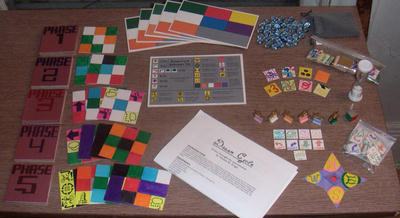
EQUIPMENT:
50 Dreamscape tiles (10 each of Phases 1 through 5)
58 Directional tiles
44 Inspiration tiles
5 Interpretation tiles
5 bicycle tokens
65 chi counters
1 sand timer
1 colored die
1 compass tile
1 rulebook
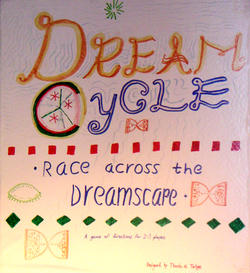
OVERVIEW:
The playing board, or Dreamscape, is constructed out of square tiles, each
comprising nine smaller squares. Each player manipulates a bicycle token across
the Dreamscape by assigning directional meanings to the colors found there.
This is done by placing Directional Tiles on an Interpretation tile containing
seven colored fields. The Directional Tiles represent either absolute directions—North,
West, East and South—or relative directions—Left, Right, Forward and Back. Each
player’s turn is divided into a Trading Phase and a Movement Phase. The Trading
Phase is used for buying and selling Directional Tiles and placing them on the
Interpretation Tile. During the Movement Phase, the player’s bicycle token is
moved along the Dreamscape in accordance with his or her Interpretation Tile.
The money used to buy and sell Directional tiles is called chi, after
the bio-energetic concept from traditional Chinese healing and mysticism.
Chi is represented here by blue glass counters. These counters represent
the power of the dreamer and are regained gradually.
Some spaces on the Dreamscape have special effects. Blue spaces give players
extra chi, black squares halt movement, and yellow squares do a variety
of things, such allowing players to draw Inspiration Tiles, which confer any
of a number of special powers.
SETUP:
Turn the Dreamscape tiles face down and separate them into stacks by their
respective Phases. Orient the compass tile on the playing surface so that its
north point is pointing in the direction you want the board to extend. For the
purposes of Dream Cycle and these rules, the four absolute directions are as
shown on the compass tile, regardless of their location in reality.
The board will consist of ten rows of three tiles each, progressing from south
to north. Each row will consist of three tiles from a single Phase, selected
and oriented randomly. The rows will progress in a staircase shape to the east
and then back to the west, all the while progressing twice through the five
phases (see diagram). Ten rows will be placed over the course of the game, using
a total of six tiles from each of the five Phases.

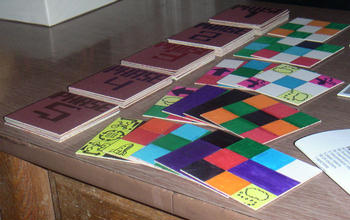 As
players’ bicycle tokens reach the far edge of the Dreamscape, new rows will
be added, one at a time. During the course of the game, the bicycle tokens may
occupy either spaces on the tiles or spaces just off the edge of the board,
which are called fringe spaces. The entire perimeter of the Dreamscape
is considered to consist of fringe spaces. Bicycle tokens may not move more
than one square away from the board—that is, out of the fringe. Squares diagonally
connected to the board are not considered fringe spaces, and thus may not be
occupied by bicycle tokens.
As
players’ bicycle tokens reach the far edge of the Dreamscape, new rows will
be added, one at a time. During the course of the game, the bicycle tokens may
occupy either spaces on the tiles or spaces just off the edge of the board,
which are called fringe spaces. The entire perimeter of the Dreamscape
is considered to consist of fringe spaces. Bicycle tokens may not move more
than one square away from the board—that is, out of the fringe. Squares diagonally
connected to the board are not considered fringe spaces, and thus may not be
occupied by bicycle tokens.
Some tiles contain black squares. These operate the same way as fringe spaces. Collectively, black squares and fringe spaces are known as doldrum spaces.
To begin the game, lay out the first two rows at the south end of the playing surface in accordance with the diagram. Sort the Directional tiles by type into piles or stacks and put them where all players can reach them. Likewise, put the chi counters in an accessible place. Give each player a bicycle token and an Interpretation Tile.
Choose a starting player. Beginning with the person to that player’s right, each player, in counter-clockwise order, chooses a starting space for his or her bicycle token. The tokens begin off the board in any of the nine spaces just south of the first row. (The starting player chooses last to minimize the advantage of going first.) No player may choose a starting space already chosen by another player.
From here, the players take turns buying and selling Directional Tiles and
moving their bicycle tokens. Each turn consists of a Buying Phase and a Moving
Phase.
BUYING PHASE:
At the beginning of your first turn, take sixteen chi counters. At the beginning of each of your subsequent turns, take one chi counter.
During this phase, you may buy and sell as many Directional Tiles as you like. When you buy a Directional Tile, you keep it until you either sell it or trade it to another player. The price of each tile and its resale value are listed on your interpretation tile, as well as in the following table:
|
DIRECTIONAL TILE |
COST |
RESALE VALUE |
|
SOUTH |
2 |
1 |
|
BACK |
4 |
2 |
|
LEFT, RIGHT, WEST, EAST |
5 |
3 |
|
FORWARD |
8 |
5 |
|
NORTH |
10 |
6 |
|
LUCIDITY |
13 |
9 |
In addition, you may trade Directional Tiles, chi counters, and Inspiration Tiles (see below) with other players whose bicycle tokens occupy the same row of tiles as your own. Any player whose bicycle token is currently in a doldrum space is not allowed to trade with other players.
If you end your Buying Phase with more than ten chi, you must return the excess to the general supply. This keeps the chi from running out. In the unlikely event that a particular type of Directional Tile runs out, it can no longer be purchased until someone sells one.
In addition to buying and selling, the other thing you must do during the Buying Phase is to assign meanings to the colors on your Interpretation Tile by putting Directional Tiles in the colored fields. You may put up to two tiles on each colored field. You do not need to place all of your Directional Tiles on your Interpretation Tile if you not wish to do so.
NOTE: You are allowed to reposition your Directional Tiles and to trade with other players during anyone’s turn, not just your own. However, you may only buy and sell tiles during your Buying Phase. You may not reposition Directional Tiles or trade with other players during your own Movement Phase.
If you like, you may place two or three chi counters on any field of your Interpretation Tile that also contains a single Directional Tile. The effect of doing this is to make that color more powerful for one turn: you will move two or three spaces when leaving squares of that color, instead of only one. At the end of your turn, chi counters used in this fashion will be lost.
Finally, if your bicycle token is currently on a doldrum space, you should position it in the direction you want it to move this turn. You may point your bicycle token in any of the four basic directions, so long as it is pointing either at a colored square or at another doldrum space, and not away from the Dreamscape entirely.
MOVEMENT PHASE:
Most of the strategy of Dream Cycle takes place during the Buying Phase. The
Movement Phase, like a dream that transpires before your eyes, is mostly automatic.
First, if your bicycle token is in a doldrum square, move it one square forward.
(To move a bicycle token forward is to move it one space in the direction it
is currently facing.)
Your bicycle token’s movement is now determined by the Directional tiles you
have placed on your Interpretation tile. If you have a Directional Tile on the
field of your Interpretation tile that matches the color of the square your
token is on, turn your token in the appropriate direction and move it one space
forward.
The appropriate direction in which to turn your token before moving it forward
is as follows:
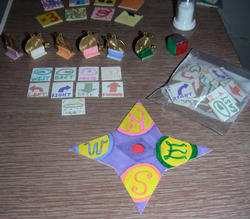
FORWARD: Do not turn your token.
LEFT: Turn your token a quarter turn to the left.
RIGHT: Turn your token a quarter turn to the right.
BACK: Turn your token completely around.
NORTH: Point your token north.
WEST: Point your token west.
EAST: Point your token east.
SOUTH: Point your token south.
LUCIDITY: Point your token in any of the four basic directions.
NOTE: Bicycle tokens always move in the direction they are facing. They
never slide to one side or back up without turning in that direction first.
The only exception is when they are pushed by other bicycle tokens (see below).
If you have placed two Directional Tiles on a single field of your Interpretation
Tile, you choose which one to follow whenever your bicycle token is on a square
of that color. You must choose to use one tile or the other, not both.
If you have placed two (or three) chi counters on one of your fields
together with a Directional Tile, then when moving off of squares of that color,
move your bicycle token two (or three) spaces forward instead of just one. The
intervening spaces have no effect, and if there are other bicycle tokens on
those spaces, you do not interact with them. If this move would take you more
than one space away from the board (i.e. "beyond the fringe", and
not onto a new row of tiles), stop in the last fringe space you pass through.
At the end of your turn, return all chi counters used in this way to
the general supply.
Continue to move your token in this fashion until one of seven things occurs:
1) Your token reaches a space for which you have no interpretation.
If you do not have any Directional Tiles on the Interpretation Tile field corresponding
to your token’s current color, your turn ends. Your token remains pointing the
same way it was pointing when it last moved.
2) Your token reaches a doldrum space.
Your token remains pointing the same way it was pointing when it last moved,
but you will be able to reorient it during the Buying Phase of your next turn,
assuming it does not get not moved before then.
3) You choose to end your token’s movement.
After moving your token off of any space (and before reorienting on the new
space), you may pay two chi counters to brake, which ends your
turn. If your token is in an endless loop, this is the only way you can end
your turn. If you brake on a yellow or blue space, its effect still applies.
4) You are caught in an endless loop and cannot brake.
If your token becomes caught in an endless loop and you do not have two chi,
nor enough Inspiration Tiles to obtain two chi, you are out of the game.
Remove your token from the board. (Your token is in an endless loop if it comes
to occupy the same space while pointing in the same direction twice in the same
turn, so long as no Inspiration Tiles have been used, no other players’ tokens
have been moved, no effects of yellow or blue spaces have occurred, and the
die has not been rolled between these two instances. If the aforementioned conditions
are met aside from the die being rolled, and if no outcome of the die roll would
break the loop, then it is considered an endless loop regardless.)
5) You are about to hit another player and choose (or are forced) to end your
movement.
If your move would put your token on a space occupied by another player’s token,
the player with more Power tiles may decide to end your movement. (See Power
tiles below.)
6) You move onto a Psychic Drain space and cannot pay two chi.
(See Psychic Drain spaces below.) If this occurs, you are out of the
game. Remove your token from the board.
7) You move off the north edge of the board after all ten rows are laid out.
If this occurs, you win the game.
If you are about to move off of the north edge of the Dreamscape, you must
immediately extend it by laying out a new row of tiles. Select three tiles randomly
from the appropriate Phase and place them according to the diagram in random
orientations. Then continue your move as normal. NOTE: You must place
a new row of tiles even when you are moving off of the north edge in a location
that would not put your token on any of the new tiles. You will end up in a
fringe space instead.
If, after a player’s turn is over, all bicycle tokens have been moved northward
of a row of Dreamscape tiles, that row of tiles is removed from the game. They
should be set aside so that they will not be randomly chosen again.
If you move off of the north edge of the Dreamscape and there have already
been ten rows placed, then you have won the game.
CONFLICTS:
If during the Movement Phase your bicycle token is about to land on a square occupied by another player’s token, you have a conflict. There are three possible outcomes to a conflict:
1) Pushing.
You move onto the contested square and your token pushes the opponent’s token one square in the direction you are facing. This does not change its orientation, but if your opponent’s token lands on a yellow or blue square, it does take effect. If you also move onto a yellow or blue square, your square takes effect first.
2) Passing.
Your token moves as normal, moving onto the same square as the opponent’s token.
3) Blocking.
The opponent’s token blocks your path and your token cannot enter the square. Your turn is over unless another Directional Tile on the field corresponding to the color your token occupies will allow you to move in another direction, or you decide to turn in a Zip Tile (see below).
Between you and any players occupying the space onto which your token would move, whoever has the most Power Tiles decides which of the three outcomes occurs. It must be one of the three above possibilities and not a combination, e.g. one token gets pushed while your token is blocked. If there is a tie for the most Power Tiles, then the Pushing outcome occurs, unless this would push your opponent’s token beyond the fringe of the board, in which case the Passing outcome occurs.
If the Pushing outcome occurs and results in another conflict with a third player, then the player involved in that conflict with the most Power Tiles decides between the Pushing and Passing outcomes, but may not choose Blocking, as that would negate the Pushing outcome of the first conflict. Ties are handled as above.
TYPES OF SQUARES:
The following list describes the various types of squares found in the Dreamscape, including what Phases they appear in and what special effects, if any, they incur.
White: These squares have no special effect. They appear in Phases 1, 2, 3 and 5.
Orange: These squares have no special effect. They appear in Phases 1, 4 and 5.
Green: These squares have no special effect. However, there are never two adjacent green squares on the same tile. Green is the only color that appears in all five Phases.
Red: These squares have no special effect. They appear in Phases 2, 3, 4 and 5.
Purple: These squares have no special effect. However, all purple squares are adjacent to at least one other purple square. They appear in Phases 4 and 5.
Blue: These are squares of spiritual renewal. Whenever you move onto a blue square, collect one chi counter. You may only collect one chi from each particular blue square in a single turn. They appear in Phases 2, 3 and 5.
Black: These operate the same way as fringe squares. Moving onto one ends your turn. However, on your following turn, you will be able to reorient your token and move one space forward for free. They appear in Phases 2, 4 and 5.
Yellow: These are special squares. There are several types of yellow squares, each with a different effect. They appear in Phases 3, 4 and 5. Their effects are as follows:
Inspiration Bonus (thought balloon): When you move onto this square, take an Inspiration tile at random.
Double Inspiration Bonus (two thought balloons): When you move onto this square, take two inspiration tiles at random.
Psychic Drain (crossed spiral): When you move onto this square, you lose two chi. If you do not have two chi, you are out of the game.
Universal Reversal (bicycle with arrows): When you land on this square, all bicycle tokens (including your own) are immediately turned completely around. (If you have a Directional Tile on the yellow field of your Interpretation Tile, its effect occurs after this reversal takes place.)
Rocket Ship (rocket): When you land on this space, all bicycle tokens are immediately moved three squares forward. If this takes any bicycle tokens off the north edge, place a new row of tiles out for them. If you have already placed ten rows, the player whose token moves farthest beyond the north edge wins. If two or more players’ tokens move equally far beyond the north edge, the game is tied between them. For this move, bicycle tokens move through each other without interference and may land on the same square, regardless of who has more Power tiles. If this move would take any bicycle token more than one square beyond the edge of the board (and not onto a new row of tiles), it stops on the last fringe space it passes through. Any player whose token lands on a blue square collects a chi counter, and any player whose token lands on a yellow square triggers the effect of that square after all other tokens have been moved forward.
Rotation (circle of arrows surrounding grid): Rotate the tile this space is on one quarter turn in the direction of the arrows. All bicycle tokens on the space are rotated along with it.
The effect of a yellow square only takes place the first time you land on it in a particular turn. Regardless of what type of square it is, your movement continues after the square’s effect has taken place, assuming you have a Directional Tile on the yellow field of your Interpretation Tile.
Fuschia: These squares are known as delta waves. These cannot be assigned an interpretation: your movement from them is automatic. These squares appear in Phases 3 and 4. There are two types:
Single arrow: Point your bicycle token in the direction of the arrow and move one space forward.
Curved arrows: turn your bicycle token a quarter turn in the direction of the arrows and move one space forward.
Silver: These squares are random. When your token moves onto one, roll the colored die and treat the square as a square of that color. If you roll silver, choose any of the other five colors on the die. If you move onto the same square again this turn, roll the die again.
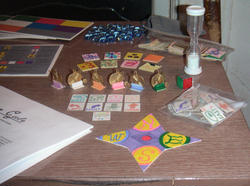
INSPIRATION TILES:
Inspiration Tiles are bonus tiles which you collect by landing on the Inspiration Bonus spaces (yellow squares with thought balloons). They provide various useful abilities. When you collect an inspiration tile, you keep it until you either turn it in or trade it to another player on the same row of tiles as yourself. In a pinch, any Inspiration Tile can be turned in at any time for a single chi. Inspiration Tiles that are turned in are returned to the general supply and may be randomly picked again. Their abilities are as follows:
Chi bonus (three circles): Turn this in to collect three chi counters.
Colored square (white, orange, green, red or black): During your Movement Phase, after you have moved onto a new square (and triggered its effect if it is yellow or blue), but before reorienting your bicycle token, you may place this tile onto a board under your bicycle token. That square now counts as its new color. You may not do this in a Fringe space. After your turn is over, you may either leave the square where it is, or pay one chi to return it to your collection of Inspiration Tiles.
Exchange (two rectangles and a equal sign): Turn this in during your Buying Phase to sell a Directional Tile for its full price, rather than its resale value.
Extra Turn (pink spring): Turn this in after you have just finished your turn in order to take another turn. You do collect a chi counter at the start of the new turn.
Fringewalker (blue tendrils over pink swirls): If you begin your Movement Phase in a doldrum space and you are pointed at another doldrum space, you may move one square forward and reorient again before beginning your normal movement. This allows you to move along the fringe of the board or through patches of black squares more quickly. Do not turn this tile in to use it.
Power (green circular pattern with orange lines): This tile helps you to decide what happens in case of a conflict (see above section). In addition, if it is your Movement Phase and you enter a conflict with another player, then if you have more Power Tiles than that player, that player must give you one chi. You can only extort one chi from each player per turn in this fashion. If the player in question does not have any chi and cannot acquire one from turning in Interpretation Tiles or by trading, he or she is out of the game. Do not turn this tile in to use it.
Shadowwalker (hovering shape with matching shadow): Whenever you move onto a yellow square, you can choose whether or not it will take effect. (You cannot make the same yellow square take effect more than once per turn.) In addition, if the tile your token is on gets rotated, you may choose either to let your token get rotated with everyone else, or to leave your token where it is and let the tile get rotated beneath you. If someone (including yourself) lands on a Universal Reversal or Rocket Ship space, you may choose whether or not to let your token be affected. Do not turn this tile in to use it.
Times 2 (x2): During your Movement Phase, you may turn in this tile to make all your remaining moves for the turn double moves, just as if you had put two chi counters on every field of your Interpretation tile. This is not cumulative with the effect of placing chi counters on your Interpretation Tile, however. This effect of this tile can be overridden by turning in a Times 3 tile.
Times 3 (x3): During your Movement Phase, you may turn in this tile to make all your remaining moves for the turn triple moves, just as if you had put three chi counters on every field of your Interpretation tile. This is not cumulative with the effect of placing chi counters on your Interpretation Tile, however. This effect of this tile can be overridden by turning in a Times 2 tile.
Zip (multicolored arrows): Turn this in during your Movement Phase after you have moved onto a new square (and triggered its effect if it is yellow or blue). Orient your token in any of the four basic directions and move one square forward. If the square you are moving to is occupied, resolve it as you would any conflict (see below). Continue your move from the new square.
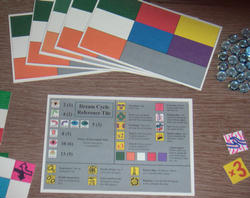
LOSING THE GAME:
It is possible to be removed from the game before it ends. This can occur if you are forced to pay chi that you do not have and cannot acquire, either because of a Psychic Drain or because another player with more Power Tiles enters a conflict with you on his or her turn. You also lose if you get into an endless loop and cannot pay two chi to brake. If you are removed from the game for any reason, remove your token from the board and return your Directional Tiles, Inspiration Tiles, and chi counters to the general supply.
WINNING THE GAME:
The first player to move his or her bicycle token off the far edge of the board after all ten rows have been placed wins the game.
SANDMAN VERSION:
For a more challenging game, use the one-minute sand timer to time each player’s
Buying Phase. Make sure that the chi counters and Directional Tiles are
sorted and easily accessible to all players. On your turn, after taking your
free chi, you may begin buying and selling as soon as you turn over the
sand timer, and you must stop when it runs out. Any Directional Tile or chi
counter is considered to be on any field in which more than half of it rests
at that point.
APPENDIX 1
THE FIVE PHASES OF SLEEP
- Sleep researchers have identified five phases of sleep that
a healthy person passes through in the course of a night. The five phases
in Dream Cycle are loosely inspired by the five phases in a cycle of sleep.
1. Also known as the hypnogogic state, this phase occurs while
a sleeper is still semi-conscious. People in this phase experience scattered
thoughts and images, and often also experience falling sensations and slight
unexpected muscular contractions. Eye and muscle activity is low.
2. Eye movement ceases and heart-rate sinks during this phase.
Sleepers in Stage 2 produce slow brain waves, but these are punctuated by rapid
bursts of activity called ‘sleep spindles.’
3. This is the beginning of deep sleep, the state in which the
body restores and maintains itself. The brain begins to produce delta waves,
the slowest rhythm of brainwave.
4. In this, the ‘deepest’ phase of sleep, the brain produces
delta waves almost exclusively. To be awakened at this stage leaves one groggy
and disoriented.
5. Known as Rapid Eye Movement (or REM) sleep, this is the phase
of dreams. In addition to rapid shifting of the eyes, REM sleep is characterized
by paralysis of the skeletal muscles and a dramatic increase in heart rate.
This type of sleep is vital to a person’s mental health.
This sequence of phases lasts 90-110 minutes and repeats in
order throughout the night. As sleep progresses, the deep sleep phases become
shorter in duration while phases 2 and 5 become longer. Even near the end of
the night, the REM phase rarely lasts more than 25 minutes.
APPENDIX 2
THE MEANING OF COLOR IN DREAMS
- Color in dreams (or its absence) is one of the first elements
a dream interpreter examines. First and foremost, as with all elements in
dreams, the dreamer himself or herself is the first authority on what individual
colors mean in any particular case. However, some patterns can be identified
that seem to remain valid for the dreams of many individuals. Authorities
assign a wide variety of interpretations to individual colors in dreams. The
following are amalgams of common meanings that are generally agreed upon for
the colors used in this game.
Green: The color of health and balance. Personal growth.
Envy, wealth. Giving, sharing and taking.
White: Purity, innocence. Transformation, a blank slate.
The end of one thing and the beginning of another.
Orange: The color of social interaction. Friendship and
career. Aggression. The power of the new.
Yellow: The color of the intellect. Personal harmony.
Hopefulness and a new direction. Good or bad health depending on the context.
Blue: This is probably the best color to see in your
dreams. Blue represents essential life force, spirituality, communication with
higher things, truth, eternity. It is the color of healing, and is associated
by some with the concept of a spirit guide.
Black: Mourning or sadness. A lack of orientation or
power. Hidden urges, desires, or sexuality.
Red: Sexuality, passion, anger, violence, humiliation.
Purple: There is little agreement on the meaning of purple.
It may signify heroism, the elite, and royalty, or it may be a color of spiritual
insight and understanding.
Fuschia: Emotional stability, understanding of the self,
readiness for change.
Silver: Intuition. The presence of astral energy. A higher
power, separate from yourself.
Return

 As
players’ bicycle tokens reach the far edge of the Dreamscape, new rows will
be added, one at a time. During the course of the game, the bicycle tokens may
occupy either spaces on the tiles or spaces just off the edge of the board,
which are called fringe spaces. The entire perimeter of the Dreamscape
is considered to consist of fringe spaces. Bicycle tokens may not move more
than one square away from the board—that is, out of the fringe. Squares diagonally
connected to the board are not considered fringe spaces, and thus may not be
occupied by bicycle tokens.
As
players’ bicycle tokens reach the far edge of the Dreamscape, new rows will
be added, one at a time. During the course of the game, the bicycle tokens may
occupy either spaces on the tiles or spaces just off the edge of the board,
which are called fringe spaces. The entire perimeter of the Dreamscape
is considered to consist of fringe spaces. Bicycle tokens may not move more
than one square away from the board—that is, out of the fringe. Squares diagonally
connected to the board are not considered fringe spaces, and thus may not be
occupied by bicycle tokens.



